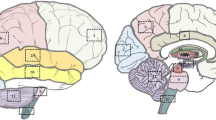Abstract
Lithium (Li) concentrations have been estimated in several peripheral tissues (serum, heart, kidney, liver and skeletal muscle) and different brain areas (cortex, caudate nucleus, hypothalamus, diencephalon, midbrain, pons-medulla and cerebellum) at different intervals (0.5 to 48 h) after administrations of 3 mEq/kg of lithium chloride (LiCl). The Li concentrations in the brain areas increased gradually, reaching their peak at 8 h; the hypothalamus showed the highest concentration measured between 0.5 and 8 h; after 8 h the highest concentration was observed in the caudate nucleus, followed approximately by those of the cortex, rest of the diencephalon, and other areas. Concentration of Li in the skeletal muscle, although initially less, was maintained at a higher percentage of the initial level for more than 24 h compared to the other peripheral tissues.
Similar content being viewed by others
References
Cade, J. F. J.: Lithium salts in the treatment of psychotic excitement. Med. J. Aust. 2, 349–352 (1949)
Cassens, G. P., Mills, A. W.: Lithium and amphetamine: opposite effects on threshold of intracranial reinforcement. Psychopharmacologia (Berl.) 30, 283–290 (1973)
Davenport, V. D.: Distribution of parenterally administered lithium in plasma, brain and muscle of rats. Amer. J. Physiol. 163, 633–641 (1950)
Ebadi, M. S., Simmons, V. J., Hendrickson, M. J., Lacy, P. S.: Pharmacokinetics of lithium and its regional distribution in rat brain. Europ. J. Pharmacol. 27, 324–329 (1974)
Furukawa, T., Ushizima, I., Ono, N.: Modifications by lithium of behavioral responses to methamphetamine and tetrabenazine. Psychopharmacologia (Berl.) 42, 243–248 (1975)
Gershon, S.: Lithium in mania. Clin. Pharmacol. Ther 11, 168–187 (1970)
Ho, A. K. S., Loh, H. H., Craves, F., Hintzemann, R. J., Gershon, S.: The effect of prolonged lithium treatment on the synthesis rate and turnover of monoamines in brain regions of rats. Europ. J. Pharmacol. 10, 72–78 (1970)
Morrison, J. M., Pritchard, H. D., Braude, M. C., D'Aguanno, W.: Plasma and brain lithium levels after lithium carbonate and lithium chloride administration by different routes in rats. Proc. Soc. exp. Biol. (N.Y.) 137, 889–892 (1971)
Perez-Cruet, J., Tagliamonte, A., Tagliamonte, P., Gessa, G. L.: Stimulation of serotonin synthesis by lithium. J. Pharmacol. exp. Ther. 178, 325–330 (1971)
Schou, M.: Lithium studies. 3. Distribution between serum and tissues. Acta pharmacol. (Kbh.) 15, 115–124 (1958)
Schou, M.: Elthium in psychiatry—a review. In: Psychopharmacology: A review of progress 1957–1967, D. H. Efron, J. O. Cole, J. Levine, and J. R. Wittenborn, eds. U.S.P.H.S. Publication No. 1836. pp. 701–718 (1968)
Segawa, T., Nakano, M.: Brain serotonin metabolism in lithiumtreated rats. Jap. J. Pharmacol. 24, 319–324 (1974)
Sheard, M. H.: Lithium in the treatment of aggression. J. nerv. ment. Dis. 160, 108–118 (1975)
Author information
Authors and Affiliations
Rights and permissions
About this article
Cite this article
Mukherjee, B.P., Bailey, P.T. & Pradhan, S.N. Temporal and regional differences in brain concentrations of lithium in rats. Psychopharmacology 48, 119–121 (1976). https://doi.org/10.1007/BF00423317
Received:
Issue Date:
DOI: https://doi.org/10.1007/BF00423317



